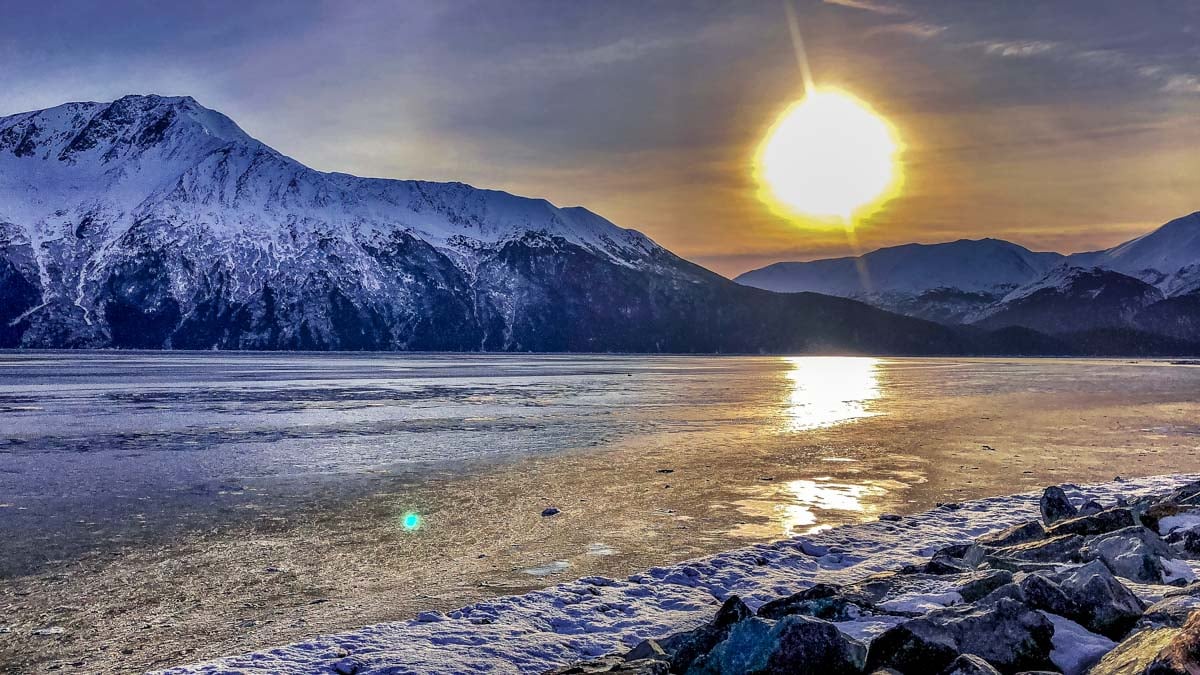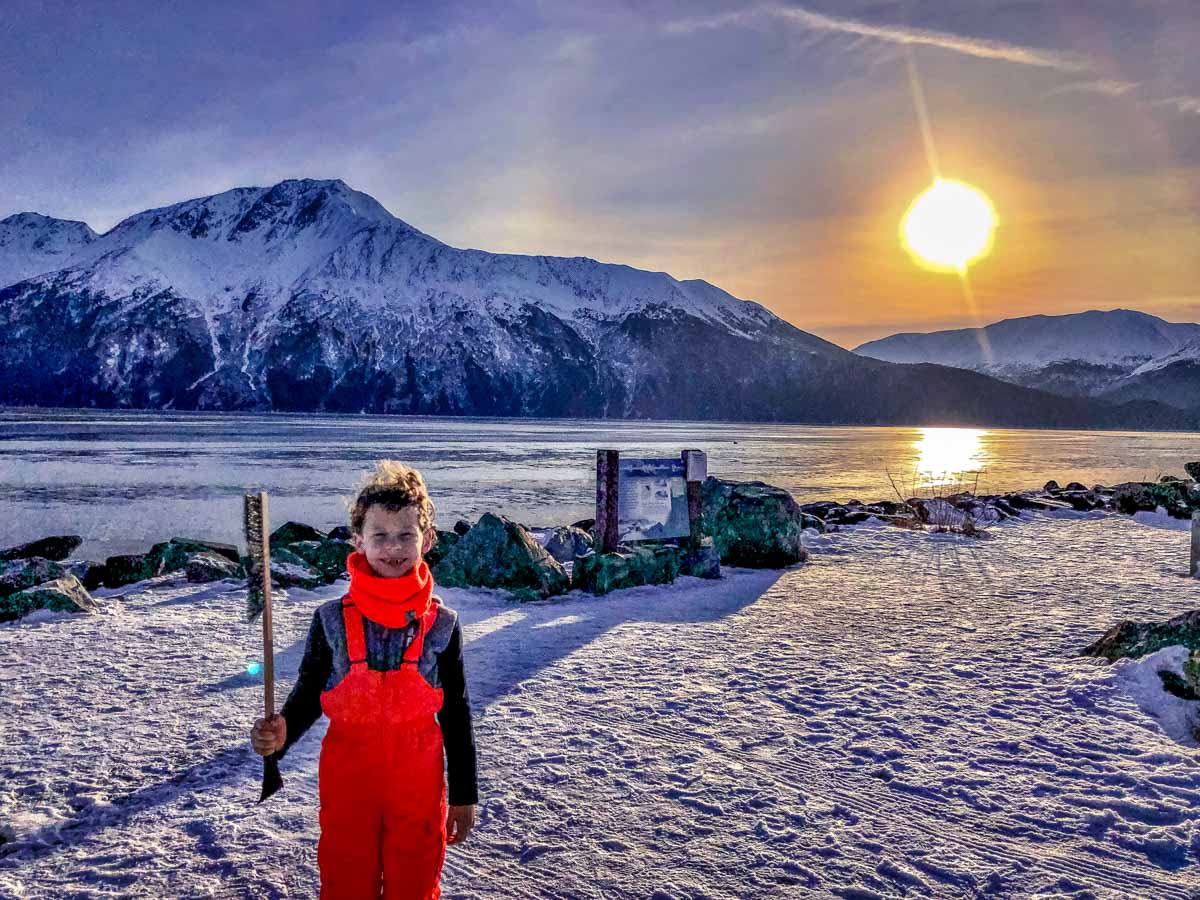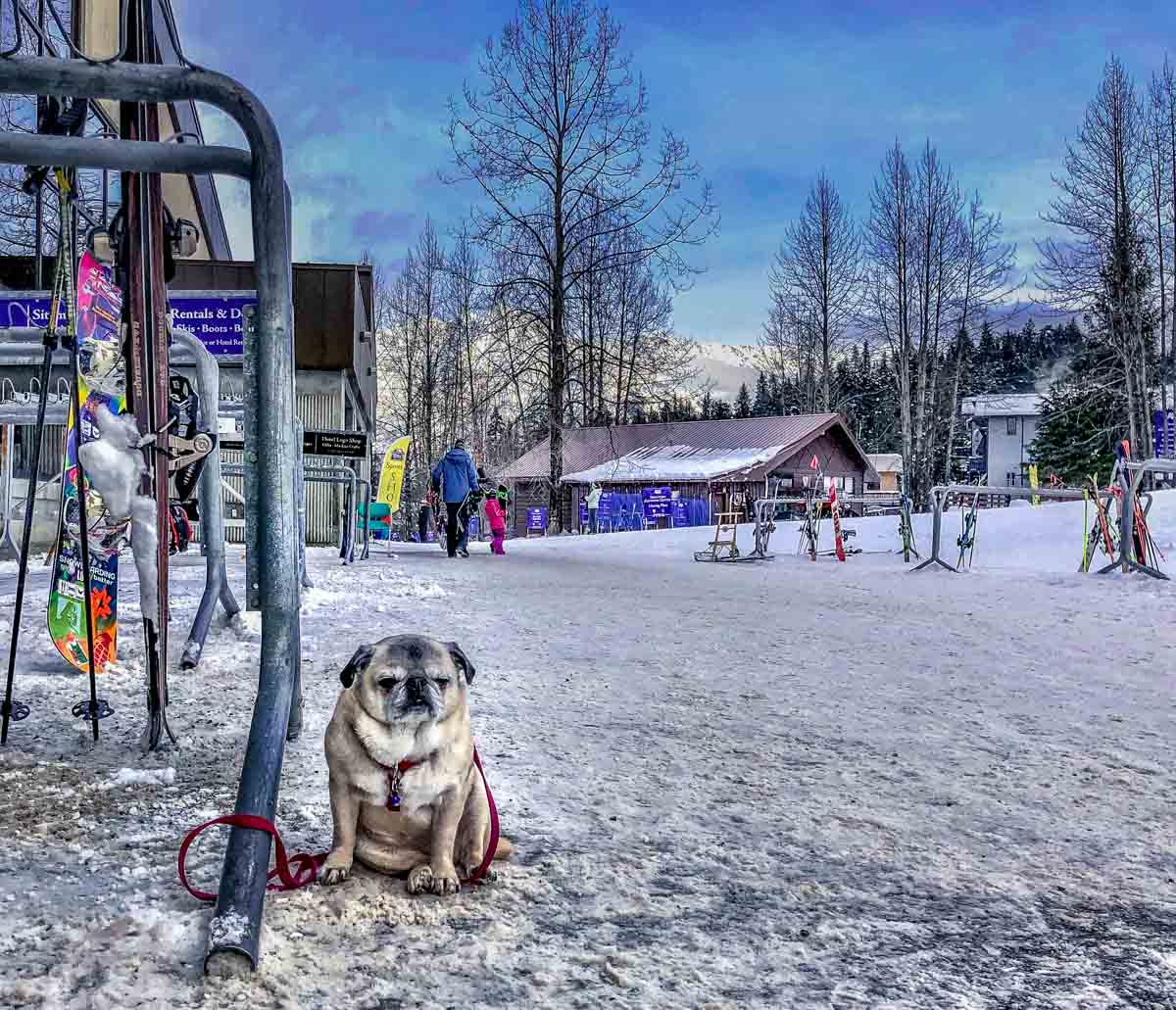Most visitors come to Alaska in the summertime to see ‘the land of the midnight sun’, but they’re missing out on the state’s best-kept secret.
When a thick blanket of snow covers the landscape, the crowds disappear, and the night sky comes alive with dancing lights, Alaska transforms into a true winter wonderland.
It’s a season of profound silence, crisp air, and a unique, rugged beauty that you have to experience to believe.
This guide is built on years of personal travel and is designed to give you the practical, on-the-ground advice you need to plan an unforgettable trip.

Why Trust This Guide?
As a veteran TV producer and feature reporter, I’ve spent my career creating travel stories from all over the world, from Beijing to the Amalfi Coast.
But this guide is personal. My family has visited Alaska annually for over a decade, giving me years of first-hand experience with everything from -30°F nights watching the aurora in Fairbanks to bluebird ski days at Alyeska.
This guide combines my professional eye for a great story with the practical, on-the-ground advice you need to plan an unforgettable adventure.

Why Visit Alaska in Winter? The Unique Magic of the Off-Season
Forget the summer crowds and mosquitoes. Winter in Alaska is a time for locals, and for the adventurous travelers who want to see the state in its most authentic form.
The locals here don’t just endure the snow; they celebrate it with festivals, sports, and a hearty spirit.
One of the biggest advantages is the value. With fewer tourists, you’ll find that hotel rates, especially in cities like Anchorage, are significantly cheaper than during the peak summer season.
This is your chance to experience the million-dollar views and epic adventures without the peak-season price tag.

Best Places to Visit in Alaska During Winter
While much of the state is accessible, a few key hubs offer the perfect combination of amenities, activities, and spectacular scenery.
Fairbanks: The Heart of the Winter Interior
If you want the quintessential “Far North” experience, Fairbanks is your destination. It gets truly cold here, but that’s part of the adventure.
Its prime location directly under the Auroral Oval makes it one of the best places on Earth to witness the Northern Lights.
Beyond the aurora, Fairbanks is a hub of unique winter culture.
My first visit to the World Ice Art Championships was mind-blowing. Artists from around the globe transform massive, one-ton blocks of “Arctic Diamond” ice—so clear you can read through it—into glowing, intricate sculptures.
It’s not just an art exhibit; with giant ice slides and mazes, it’s an interactive frozen playground.
Fairbanks is also a fantastic base for dog mushing tours and trips to the wonderfully relaxing Chena Hot Springs.

Anchorage: Urban Comforts and Wild Adventures
As Alaska’s largest city, Anchorage offers the perfect blend of city comforts and immediate access to the wilderness.
The city is a winter wonderland, with an extensive network of groomed and lighted cross-country ski trails that crisscross the entire town.
One of my favorite local pastimes is renting a pair of fat tire bikes and exploring the snow-packed coastal trail, with incredible views of the mountains across the water.
Anchorage is also the epicenter of two of Alaska’s biggest winter events: the Fur Rendezvous (“Fur Rondy”) festival in February and the ceremonial start of the Iditarod Trail Sled Dog Race on the first Saturday in March.

Girdwood & Alyeska Resort: Alaska’s Premier Ski Destination
Just a scenic 40-mile drive south of Anchorage lies Girdwood, Alaska’s main ski town.
It’s home to Alyeska Resort, the state’s largest downhill ski area, known for its challenging runs and deep annual snowfall.
Taking the aerial tram up the mountain offers breathtaking views of the surrounding glaciers and ocean inlets.
For a touch of luxury, the new Alyeska Nordic Spa is a must-do. I spent an afternoon there moving between the hot and cold pools nestled in the forest, and it was the perfect way to relax after a day on the slopes.
Other Noteworthy Destinations
- Talkeetna: A quirky small town with incredible views of Denali on clear days.13
- Mat-Su Valley (Palmer/Wasilla): A hub for snowmobiling and helicopter tours into the mountains.13
- Juneau: Alaska’s capital offers a different flavor of winter in the Southeast, with skiing at Eaglecrest Ski Area and stunning glacier views.13
Top 15 Unforgettable Winter Activities in Alaska
Chasing the Aurora: A Guide to the Northern Lights
Seeing the aurora borealis is a bucket-list experience for many, and for good reason.
The best viewing season runs from late August to April when the nights are long and dark.
While you can sometimes see them from Anchorage, your best bet is to head to the Interior, near Fairbanks, Coldfoot, or Wiseman.
Pro Tip: Don’t just plan for one night. Aurora activity and weather are unpredictable. I always recommend a stay of at least three nights to maximize your chances.
You can monitor forecasts from the University of Alaska Fairbanks’ Geophysical Institute, but joining a guided tour is often easiest.
They’ll take you away from city lights and often provide a warming hut with hot chocolate—a welcome treat when you’re waiting in the cold.

Getting a great photo of the aurora requires the right camera settings and a bit of patience. Our guides on nature art and photography can help you prepare to capture the perfect shot.
Dog Sledding: Experience Alaska’s State Sport
There’s nothing more Alaskan than the sound of excited sled dogs and the whisper of a sled gliding over snow. Mushing is the state sport, and you can experience it firsthand.
Tours range from short one-hour rides to multi-day backcountry adventures. On my last tour near Willow, I learned the importance of a balaclava—the wind can be surprisingly sharp.
It was fascinating to meet the dogs, learn their personalities, and see the incredible bond they share with their musher.
Celebrate the Season: Alaska’s Top Winter Festivals
- World Ice Art Championships (Fairbanks): This month-long event (mid-February to late March) is a must-see, featuring enormous, glowing ice sculptures.
- Fur Rendezvous (Anchorage): Known as “Fur Rondy,” this 12-day festival in February is wonderfully quirky. I’ve watched everything from the Running of the Reindeer to outhouse races and snowshoe softball.
- Iditarod Ceremonial Start (Anchorage): On the first Saturday in March, downtown Anchorage transforms for the start of the 1,000-mile “Last Great Race.” It’s an incredible opportunity to meet the mushers and their amazing canine athletes up close.
Skiing & Snowboarding: From Resorts to Backcountry
Besides the world-class downhill skiing at Alyeska Resort, Alaska has incredible Nordic (cross-country) skiing opportunities.
Anchorage and Fairbanks both have extensive groomed trail systems, many of which are lit for night skiing—a magical experience.
Motorized Adventures: Snowmobiling and Flightseeing
Locals call them “snowmachines,” and they are a fantastic way to access the vast backcountry. Guided tours can take you to glaciers, frozen rivers, and remote valleys. Winter flightseeing is another spectacular option.
Seeing the massive, snow-covered peaks of the Alaska Range or Denali from a ski-equipped plane is an experience you will never forget.
On the Ice: Skating and Fishing
Ice skating on a frozen, plowed lake is a classic Alaskan pastime.
For something more adventurous, try a guided ice fishing trip. They often provide a heated hut and all the gear you need to stay comfortable while waiting for a bite.
Human-Powered Fun: Fat Tire Biking and Snowshoeing
Fat tire biking has exploded in popularity, with wide tires that float over packed snow.
It’s a fun and surprisingly accessible way to explore local trails. Snowshoeing offers a quieter way to immerse yourself in the silent, snow-covered forests.
Snowshoeing is an accessible way to explore silent, snow-covered forests, and many of the same hiking skills and safety principles apply.” OR “For extra stability on packed snow and icy trails, I always recommend using a good pair of trekking poles.
A Unique Thaw: Hot Springs and Nordic Spas
Soaking in the mineral-rich waters of Chena Hot Springs near Fairbanks while it’s snowing or the aurora is overhead is pure magic.
For a more modern, luxurious experience, the Alyeska Nordic Spa in Girdwood offers a circuit of hot pools, saunas, and relaxation areas that will soothe any tired muscles.
Planning Your Perfect Alaska Winter Trip: A Practical Guide
What to Wear: The Art of Layering for the Alaskan Winter
This is the most critical part of planning. There’s no such thing as bad weather, only bad gear. The key is layering—do not wear cotton!
- Base Layer: Moisture-wicking long underwear (merino wool or synthetics).
- Mid Layer: An insulating layer like a fleece jacket or a puffy down/synthetic vest.
- Outer Layer (Shell): A windproof and waterproof (or at least water-resistant) jacket and snow pants.
- Extremities: This is where you’ll feel the cold first. You need warm, insulated, and waterproof boots; wool socks; a hat that covers your ears; a neck gaiter or balaclava; and insulated mittens (they’re warmer than gloves).
- Insider Tip: If you’re short on gear, don’t worry. You can often rent high-quality parkas and boots in places like Fairbanks. Also, many tour operators for activities like snowmobiling will provide you with heavy-duty outer gear.
For day trips, you’ll want a comfortable pack to carry extra layers, water, and snacks. Here’s our complete guide on how to choose a hiking backpack.
Understanding Winter Daylight and Weather
The days are short, but the light is beautiful. Around the winter solstice in late December, Anchorage gets about 5.5 hours of daylight, while Fairbanks gets less than 4.
But don’t let that deter you; the low-angle sun creates a perpetual state of sunrise and sunset, casting a warm alpenglow on the snowy mountains.
After the solstice, the daylight returns surprisingly fast, gaining several minutes each day.
For a good balance of dark nights for aurora viewing and daylight for activities, I recommend visiting in February or March.
|
Month |
Anchorage Avg. Daylight |
Fairbanks Avg. Daylight |
Notes |
|---|---|---|---|
|
December |
~5.5 hours |
~3.75 hours |
Darkest nights, best for aurora viewing. |
|
January |
~6.5 hours |
~5 hours |
Still very dark, cold temperatures. |
|
February |
~9 hours |
~8.5 hours |
More sun for activities, major festivals begin. |
|
March |
~12 hours |
~11.75 hours |
Spring skiing conditions, Iditarod, still great aurora chances. |
Getting Around in Winter
For travel between Anchorage and Fairbanks, I can’t recommend the Alaska Railroad’s Aurora Winter Train enough.
It’s a stunning 12-hour journey through a pristine, frozen landscape that you simply can’t see from the road.
If you plan to drive yourself, you absolutely must rent an all-wheel-drive or 4-wheel-drive vehicle with good winter tires.








What breath-taking pictures! You gave a great sum up of touring Alaska in the winter. I’ve always wanted to visit Alaska — it’s been a dream my mom and I have shared for a while now — but never thought of visiting in the winter. The price difference of hotels between the summer and the winter was surprising, but definitely something to take advantage of. Who knows, maybe I’ll get to visit some day and see the Northern Lights. Great article, I’ll keep an eye out for more of your travel posts!